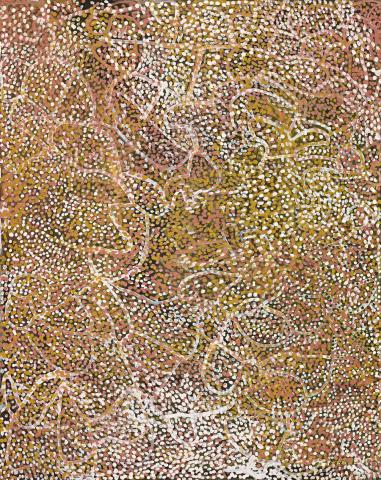ANATYE (BUSH POTATO), 1989
EMILY KAME KNGWARREYE
synthetic polymer paint on linen
151.0 x 120.0 cm
inscribed verso: artist's name and Delmore Gallery cat. D0O9
Delmore Gallery, Alice Springs (cat. D0O9 and EK 30I04)
Gallery Gabrielle Pizzi, Melbourne (label attached verso)
Private collection, Melbourne, acquired from the above in 1990
It was during the 1990s that Emily Kngwarreye emerged as one of Australia's leading contemporary painters. Bursting onto the art scene, the demand for her work was unprecedented as international and local collectors and museums clamoured to obtain an 'Emily'. In a very short period and at the end of her life, Kngwarreye was hailed as 'an outstanding abstract painter, certainly among the best Australian artists, arguably among the best of her time'.1 The bold, fluid lines and bright, vivid colours that are placed hypnotically over the surface are defining elements in her coveted work.
Illustrating the bush potato or yam, Anatye, 1989 is a meticulous and shimmering example of Kngwarreye's highly-celebrated early paintings. Produced in the first year of her short painting career, this work is a flurry of movement through the linear markings of the yam roots that trail their way across the linen and the pulsing dots of the surrounding seeds, flowers and leaves. Anatye is alive with ritual and ceremony. This work belongs to the period between 1989-91 where the artist applied clouds of fine dots with small brushes in various palettes, creating visions of tonal splendour. Renowned for her dexterity with colours, Kngwarreye utilises overlapping hues that emerge in dense waves adding a boundless depth to the composition. This visual depth is matched by the cosmological and traditional information that is layered underneath the paint. The linear marks that are obscured by the dots may indicate routes to sacred ceremonial sites or important places to find food, water and shelter.
Kngwarreye's paintings are complex and vibrant visions of her country and Awelye or women's ceremonies. Despite finding artistic recognition late in her life, her practice had been developing for many years as she painted her body and objects during rituals and ceremonies. Kngwarreye was a senior Anmatyerre woman, a caretaker of custodian tales and a respected elder, and it was this sacred knowledge that informed her work. The detailed iridescent surface of Anatye unites her knowledge and history in a wondrous example. As discussed by Jennifer Isaacs,'all the paintings of Emily Kngwarreye, so spectacular and diverse in style, express a central theme- that of her identification with the earth and land itself: Anmatyerre country, the country of the yam and the emu'.2
1. Smith, T., 'Kngwarreye Woman Abstract Painter', in Emily Kngwarreye Paintings, Craftsman House, Sydney, 1998, p. 24
2. Isaacs, J., 'Anmatyerre Woman', in Emily Kngwarreye Paintings, Craftsman House, Sydney, 1998, p. 12
CASSI YOUNG
